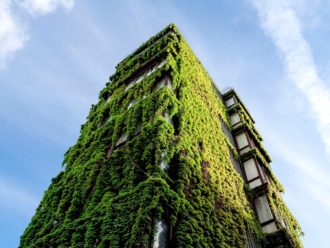Hospitals are bad for our health. So are schools, fire service stations and shopping malls. Then there are bridges and communication networks, which are also a threat to our wellbeing. Constructed with the best of intentions, and many years ago in most cases, the built environment is a huge contributor to the negative changes effecting our climate.
Indeed, property is responsible for close to half of the world’s carbon emissions (42%), says Architecture 2030, a think tank working to decarbonise the built environment.
Powering, heating and cooling buildings generates 27% of the world’s climate-harming gases, while the extraction, processing and transportation of the cement, iron, steel and aluminium used in the construction of property and infrastructure contributes a further 15% to the built environment’s rap sheet.
And the demand for new properties is expected to rise as human populations continue to grow. Then the energy transition, digitalisation and upgrading aging assets will all push demand for new infrastructure higher.
Indeed, the United Nations believes that three-quarters of the infrastructure that will be standing across the world in 2050 is yet to be built.
The International Energy Agency expands on this figure by predicting that around 2.6 trillion square foot of new floor space will exist in 2060 – this, they say, is the equivalent of re- building New York City each month.
Clean thinking
The good news is that investors are taking the ESG performance of their property portfolios seriously. “Sustainability certifications were once deemed a nice to have but now they are a ‘licence to operate’,” says Simon Durkin, BlackRock’s global head of real estate research and analytics.
Indeed, to meet energy-efficiency standards, investors are putting their property portfolios on a path to net zero. “It is the responsibility of managers to ensure that assets and funds are aligned with the prevailing ESG certifications,” Durkin adds.
One firm that has put £36.9bn worth of offices, retail, industrial, residential and infrastructure assets as well as debt on a net-zero pathway is Legal & General Investment Management (LGIM). “Over time we aim to help transition existing assets in the right direction or finance new assets and projects that are helping the world move in the right direction,” says Laura Brown, head of client and sustainability solutions at LGIM.
Indeed, not all real estate and infrastructure assets are created equally. Many are now designed to make a positive impact on the environment. These new assets include building and managing sources of clean energy.
“Real assets, in our view play a critical role [in the energy and climate transition],” Brown says. However, the major issue is the emissions generated by the legacy assets, those which have been standing for decades. And there are many of them.
For Shuen Chan, head of responsible investment and sustainability at LGIM Real Assets, decarbonisation is about seeking to protect asset value and deliver value creation for the assets the firm owns.
“The majority of these buildings will be around in 2050 and beyond,” Chan says. “So we engage with our tenants to understand the emissions and together we align towards a solution.
“For example, we have invested in dashboard technology that shows where energy is consumed, so we can help our tenants to reduce their usage,” she adds. “We are helping our tenants to cut their energy costs, while cutting their carbon emissions.”
Other ways of reducing the harmful emissions from legacy structures include replacing gas-fired installations with a sustainable energy source, such as solar panels. Improving natural light and air circulation are other options.
A new cycle
But why, after so long, is reducing the carbon emissions of bricks and mortar now seen as a strategy that will improve value?
Well, for years investors benefitted from the prolonged low interest-rate environment that followed the financial crisis. However, this new cycle is different and it is recognised that future performance will be driven by value creation and income growth throughout the asset class, Durkin says.
“There was a different driver of real estate performance post-financial crisis, yields turbo charged by zero interest rates, however we now see sustainability and ESG certifications at the front of many investors’ agenda,” he adds.
Beyond climate
But the E in ESG is no longer solely about the environment. “Biodiversity has climbed up the agenda,” Chan says. Since February, it has been mandatory in the UK for construction projects to consider the natural habitats of land being developed.
In short, wildlife has to benefit from the expansion of the built environment.
“But we are going beyond those regulations,” Chan says, explaining that LGIM is piloting baseline assessments across its standing assets in a bid to improve their biodiversity profile. But a strong ESG performance is not just the result of addressing environmental risk.
“We talk a lot about the E in ESG, but the S is equally as important and interconnected,” Durkin says. As an example, he points to the employees working at a property owned by a BlackRock-managed fund, who formed a bee-keeping group and placed hives around the site. Any proceeds from selling the honey are donated to a partner charity.
“That is all accretive to the general well-being of people who are working in buildings, and post pandemic we are all far more aware of wellbeing,” Durkin adds. “The narrative is increasingly expanding from the E into the S as they are often related.”
Legal & General has built a place-based social impact framework around the core pillars of inclusive economy; health, well-being and quality of life; and climate and nature. Then there is a toolkit to apply these principles across the investment lifecycle, from new developments to assets that have been fully operational for years.
Driving value
With the energy transition having such an impact on valuations and rental income, how should investors assess real assets?
There are four pillars that Durkin considers when assessing the impact of sustainability on a property in addition to physical climate risks: regulation, the lending market, the investment environment and the occupiers.
And through the occupier lens, he is seeing an interesting trend. “Some companies simply will not occupy buildings that do not support the specific ESG commitments that they have made at the corporate level.”
The importance of which, Durkin says, should not be underestimated. “Real estate performance is 80% driven by the income stream, so focusing on the tenant needs is absolutely critical.” Then there is regulation, which can be volatile, and its direction cannot always be predicted. “Regulation is integrated with politics, which can be difficult to predict, although over the longer term regulation is unlikely to become looser.
“Most likely it will become more restrictive over time,” he adds. “There will be bumps in the road, as we have seen in the UK, but the overall trajectory is relatively known.”
On the funding side, real estate is a debt-funded asset class, making the probability of re-financing in the next five years absolutely critical. Then there is the issue of some traditional bank lenders offering a preferential funding rate if certain sustainability targets are achieved through green finance initiatives.
“It is a much more complex picture for investors as we think about how this impacts value,” Durkin says. “There is evidence now to show that it is less of a green premium and more of a brown discount for values and for rents in the region of 15% to 20%. So, it is meaningful today, but is not something that will impact value in the future.”
These four issues impact what returns an investor is ultimately able to achieve from investing in a property. “Gone are the days where a decision is made on an asset purely based on the cashflow forecast. You have to broaden that conversation to include the drivers of occupational decisions and your ability to finance the asset,” Durkin says.
For LGIM, when assessing a real asset it has to meet the needs of the community and is commercially beneficial in that local infrastructure needs to drive footfall towards shops and restaurants.
Then there is collaboration. “We are an asset manager, a builder and an operator, we are not experts in community engagement,” Chan says. “So we need to work with the right partners on the ground to drive specific outcomes.”
These partners for LGIM include the NHS, universities as well as community and educational organisations. It is clear that if asset owners do not invest in improving the sustainable performance of their properties then not only will value and rental income fall, but they face trying to attract occupiers from a smaller pool of companies. It will also increase the illiquidity of an already illiquid asset.
For Brown, net zero, biodiversity and social impact strategies are about increasing the value of assets and withstanding any risks that might be out there. “The purpose of sustainability in this space is an intrinsic part of the investment process and as a result intrinsic to adding value in these investments.”
Chan says that smaller companies are less motivated by ticking boxes. They want a building where there is better air quality, is connected to nature and the local community to empower staff back to work. “It is a more conducive environment to work in, particularly post pandemic where we all stuck in our little holes and people need to be attracted back to the office.
“These are important behavioural considerations for how we design and operate our buildings,” she adds. “We think holistically about the whole package and what it means to an occupier. It is much more than just a green building; it has to be future fit. That is being resilient to climate change and purposeful for the communities that use it.
“Green certifications have been around for a long time but have now come to the fore,” Chan says. “Our head of development describes them as a set of scout badges for buildings. “But those badges are not a tick in a box, they ensure that there is a level playing field by getting our buildings to a certain standard that meet the objectives our tenants require,” Chan adds.
Follow the trend
Yet Durkin is witnessing a change in the narrative as some investors are focusing beyond certifications and sustainability labels towards understanding the actual carbon output of an as- set and how owners can impact those emissions.
“Ideally, the two would perfectly nest but we are all aware that filling in a spreadsheet to get a rating does not directly translate to actual carbon reductions,” he says. “So, we are starting to see that shift.”
Durkin also expects to see a greater understanding of the social impact that a sustainable built environment can have, particularly concerning health and wellbeing. “Better air quality and the integration of biodiversity ultimately creates a places where people want to be,” he adds.
It is not just about sustainability. The Covid lockdowns have left landlords with problems, and top of the list is occupiers want to be located in an area that can draw their staff away from the home office.
“You have a far greater degree of success if an office is located in a place where they truly want to spend time and offers a working environment that supports health and wellbeing,” Durkin says. “That is one of the challenges emerging in London.”
A location has to be vibrant with shops, restaurants, leisure facilities and green spaces. “King’s Cross is a great example of a market that has emerged that fuses offices alongside other uses,” Durkin says. “People are far more cognizant now of where they want to work and spend their time. So hence that will be a draw for occupiers to want to locate in those places. King’s Cross ticks all of those boxes.”
For Brown, we will see a continued focus not only on the impact the built environment has on nature but also on the people living in the area.
“Climate remains at the heart of things, but place-based impacts and thinking through the connectedness of the different components of ESG is increasingly becoming important,” she says.
Whatever the coming years have in store for us, the one certainty is that the build environment will expand and the purposes it serves will be different.
The fabric of cities changes over time as the built environment changes to meet our evolving needs. “As landlords, we have to ensure that we are evolving our buildings as regulation, technology and tenant preferences evolve,” Durkin says.





Comments